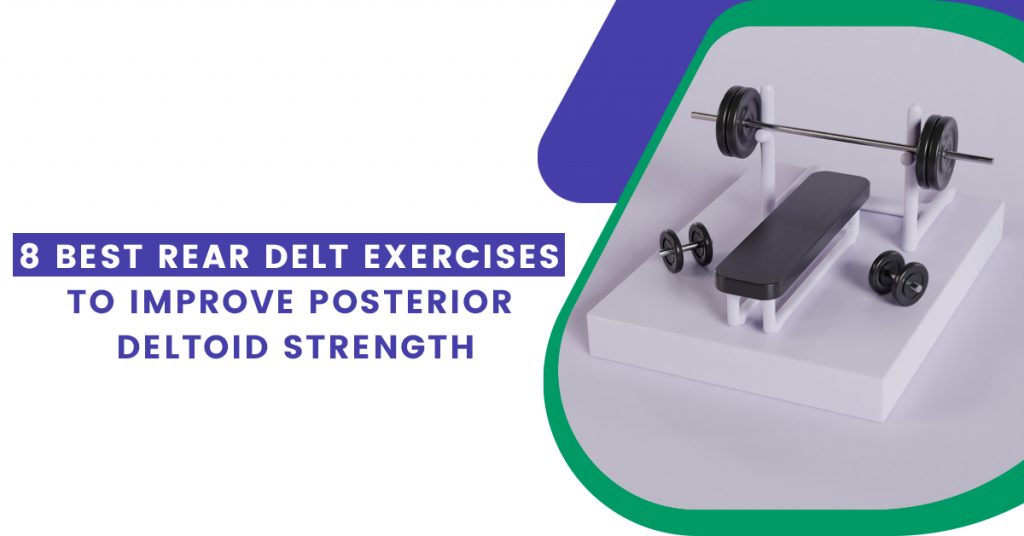It’s challenging to just force yourself to stand up straight when your shoulders begin to hunch and you begin to slouch. The greatest rear delt exercises help to build the muscles that enable you to more safely place your shoulder blades and stand tall by strengthening those muscles.
Many of our regular routines negatively impact our posture. a crucial one? James Higgins, PT, DPT, OCS, at Integrative Physical Therapy of NYC, tells SELF that prolonged periods of sitting
That may be the result of computer work, which frequently requires us to spend many hours each day hunched over our desks or couches. Or from staring intently at our mobile gadgets, which frequently causes us to hunch our heads forward and round our shoulders.
This is particularly true for those who frequently engage in these activities without stopping—not even for a quick trip to the restroom to loosen up their muscles and change the position of their shoulders.
Fortunately, there are a variety of rear delt exercises you can perform to build up the minor but significant muscles in the back of your shoulder, which will help you stand more upright.
You should incorporate a variety of rear deltoid workouts into your routine, ranging from easy isolation exercises to complex compound motions. But first, let’s talk about why your rear deltoids are so crucial in the first place.
What are your rear deltoids?
Your deltoid muscle, which is located on the shoulder, is divided into three sections: the anterior deltoids (front delts), which assist in moving your arm forward; the lateral deltoids (side delts), which assist in moving your arm up and down and out to the side; and the posterior deltoids (rear delts), which assist in moving your arm backward.
Together, they support muscles in that region while also assisting with extension (as when you swing your arms behind you), external rotation (when you elevate your arms to dry the back of your head), and horizontal abduction (when you pull your shoulders back to throw).
Rear Delt Exercises:
You may strengthen your shoulders overall and your rear deltoid by performing these 8 exercises. Consider including a few of these exercises in your weekly strength-training routine.
1. Bent Over Dumbbell Reverse Fly
Reverse flies can be performed with belts over dumbbells lying face down on an inclined bench (supported) or bent over (self-supported). You need to get your body close to parallel to the ground, or slightly angled up from that to ensure gravitation still pulls the weights downward.
Reverse fly with chest support is a great option because it minimizes body swing and momentum, and it does not allow lifters to change their angle to make the movement easier as they become tired (the more upright you are, the easier the movement and the less it targets your rear delts).
How To Do It:
- Grab two light dumbbells, one in each hand, and hinge at the hips as if you were doing a bent-over row or an RDL.
- The shoulders should be slightly higher than the hips, your back should be flat and your chest should be up.
- Straighten your arms below your body with your palms facing each other.
- Alternatively, you can place the palms facing you with the thumbs next to each other (which will also isolate the rear delts).
- Pull the weights outwards (laterally), keeping the elbows straight during each phase, as if you were reaching for the walls (with a slight bend in the elbows).
- Make sure you lift the weights as high as you can without hunching forwards or losing the contraction in the rear delts.
- Following the wide arcing path in which the weights were raised, slowly lower the weights down for a couple of seconds at the top of the movement.
You can Read Also: Hepatitis: What are Hepatitis, Types, Symptoms, Causes, and Treatment
2. Rear deltoid machine
There is a machine at the gym that is specifically made to work the posterior deltoid muscles. This makes it quite simple to challenge certain muscles while safely isolating them.
How To Do It:
- The machine should be positioned so that you are facing the pad when you sit on it. Even though it seems like you’re sitting on it backward, you’re actually positioned perfectly for this exercise. Seat height should be adjusted so that your shoulders are level with the handles in front of you.
- Press your arms back, keeping them straight or slightly bent, while holding the handles, palms down, or facing each other.
- Make a pair of elevator doors by squeezing your shoulder blades together.
- Keep your hands in front of you for two seconds, then return to the starting position. Slowly and carefully perform this exercise.
- Do 10–12 repetitions.
3. Single-arm bent-over row
The best days to incorporate this technique are the days you work your shoulders and back. Try to end your back day with this multi-joint exercise to strengthen your posterior deltoid muscles.
How To Do It:
- Lie on your left side and rest your left hand and knee on the bench. Straighten your left elbow.
- Keep your right foot on the floor for support as you extend your right leg behind you. Your spine should remain neutral and your back should be flat.
- Your right hand should hold a medium to the heavy dumbbell, with your arm reaching down to the ground.
- The upper arm should be roughly parallel to the lower chest when you bend your right elbow.
- As you perform the movement, squeeze your shoulder blades together.
- Decrease the weight with control.
- Before switching arms, repeat the exercise on one side for 10–12 repetitions.
4. Incline Dumbbell Rear Delt Flys
The bent-over dumbbell reverse flies from exercise #1 are modified in this workout. The front of your torso is supported by a bench when performing the incline dumbbell rear delt fly.
By preventing any forward and backward body swaying momentum, lying face down on a bench isolates the rear delts. Additionally, because it demands less active use of the core muscles, you may concentrate solely on your delts.
How To Do It:
- Set up a bench at a 45-degree angle and lie face down. A bench should be positioned so that the top belongs to your nipples.
- Make sure your shoulders are rotated slightly externally and use a neutral grip on the dumbbell in each hand (palms facing one another).
- To establish a stable foundation, plant your feet firmly.
- Maintain a neutral spine by tucking your chin and looking straight ahead.
- Keeping your arms flexed and your elbows bent, inhale as you keep your arms flexed.
- To engage the rear delts, exhale and squeeze your shoulder blades together. The dumbbells should be lifted laterally to your sides. You should keep your hands close to your shoulders and will not let your hands move forward or behind your torso.
- Take a deep breath as you lower the dumbbells back to your sides.
- Repeat for the reps and sets in the desired number.
5. Dumbbell Face Pulls
If a cable machine is not accessible, you can perform face pulls with dumbbells as a convenient substitute. Face pulls are frequently performed using a cable machine.
Face pulls, which entail drawing the weight towards your face while spreading your arms out to your sides so that your elbows go behind your body, are excellent for targeting the rear delts.
How To Do It:
- Standing with your feet hip-width apart is the best position. Put your torso parallel to the ground by pivoting forward at the waist. Be sure to keep your knees bent softly and your abdominal muscles braced.
- Using an overhand grip, hold a dumbbell in each hand with your arms straight and shoulders relaxed.
- As you pull the dumbbells toward either side of your face, bend your elbows and squeeze your rear delts.
- Dumbbells should be stopped when they reach eye level. While holding for a second, squeeze the rear delts.
- Then slowly lower the dumbbells back to the starting place.
- Repeat the exercise for the desired number.
You can Read Also: Malaria: Causes, Symptoms, Diagnosis, and Treatment
6. Dumbbell Incline Y Raises
The dumbbell Y raise is a fantastic general upper back strengthening exercise. They recruit the back delts in addition to the lower trapezius and rhomboids as their main muscle groups.
The incline dumbbell Y raise is a useful exercise since it works practically all of the shoulders and back muscles, enhancing your posture and stability during other lifts.
How To Do It:
- Position a bench at 45 degrees and lie face down on it. If you are sitting on a bench, the top of the bench should be level with your nipples.
- Using an overhand grip, hold a dumbbell in each hand and let your arms hang straight down.
- Make sure your feet are firmly planted on the ground, and tuck your chin to protect your upper spine.
- Squeeze your shoulder blades together and lift the dumbbells up and out diagonally so your body forms a Y shape. Straighten your arms without locking them out (keep your elbows bent). Maintain a straight line between your forearms and wrists while stretching.
- After lifting the dumbbells, pause and lower them slowly back toward the ground.
- Repeat the exercise for the desired number.
7. Seated Bent-Over Rear Delt Rows
By sitting down on a bench to exclude any help from the legs, the seated bent-over rear delt row isolates the back and shoulder muscles. This exercise targets the rear delt from a variety of angles by involving horizontal shoulder abduction as well as moving the elbows behind the body.
How To Do It:
- Make sure your feet are hip-width apart while sitting on the short end of a bench.
- With both hands, grab a dumbbell in an overhand grip so that your palms face inward.
- Ensure that the dumbbells are directly underneath your shoulders by hanging them at the waist and maintaining a neutral spine. You should rest the dumbbells behind your calf muscles while holding your arms straight.
- By gazing straight down and tucking the chin slightly, you can maintain a neutral upper spine.
- Retract your rear delts by pulling the dumbbells back towards your torso with your shoulder blades together.
- Your elbows should be bent and behind your torso as well as the dumbbells should travel just above your knees by the time you stop.
- Ensure that the arms are fully straightened before returning the dumbbells to their starting position.
- Repeat the exercise for the desired number.
8. Cable Reverse Flye
Standing can be used to do the cable reverse fly-in instead of squatting with dumbbells. Cable height should be adjusted at chest/shoulder level for effective back delt training. To train the read delts and delt/traps, you can also lower the cable height settings.
How To Do It:
- Set up a cable system at shoulder height, with the pulley at your shoulder
- In each hand, grasp the handles.
- The first thing you need to do is cross your arms so that when you grab the handles, you can grab the left handle with your left hand and vice versa.
- The arms should be held out to the side, with the elbows straightened and the handles pulled apart laterally.
- As soon as you hold that position for a few seconds, slowly lower the weights back to the stack, and repeat for repetitions.









